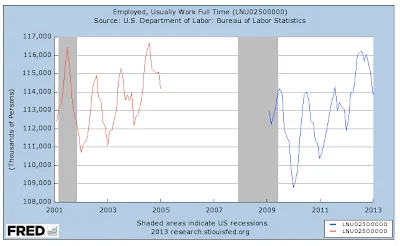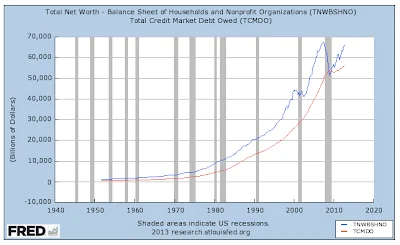Barry Ritholtz here recently had some fun with the goldbugs, whom he ridicules as devotees of a "religious cult".
The piece is regrettably inflammatory. Doesn't he know he's writing off the whole world as a bunch of religious kooks in this temper tantrum? That's pretty much what ideologues do when reality won't cooperate with their theories, but surely he must know that sovereigns and central banks the world over continue to build their hoardes of gold year upon year, now approaching 32,000 tonnes and 20% of all the stuff ever pulled out of the ground. That's quite the foundation for the edifice of the worldwide church of gold.
The piece is regrettably inflammatory. Doesn't he know he's writing off the whole world as a bunch of religious kooks in this temper tantrum? That's pretty much what ideologues do when reality won't cooperate with their theories, but surely he must know that sovereigns and central banks the world over continue to build their hoardes of gold year upon year, now approaching 32,000 tonnes and 20% of all the stuff ever pulled out of the ground. That's quite the foundation for the edifice of the worldwide church of gold.
In fact, many of the central banks in particular have been on a tear recently, acquiring the stuff in quantities not seen in 30 years. Evidently they are to a man possessed by the Oracle of Au (pronounced "Ow"). But try as they may to acquire new gold reserves, no one of them yet even comes close to the chief priest bowing and scraping before the barbarous relic, namely the USA, the number one holder of gold in reserve to the tune of 8,134 tonnes (not to be confused with tons).
That even the USA with all its fiat money still considers this gold to be the most sublime of all currencies can be seen in its own gold issues. Gold Eagles, in one ounce sizes down to tenth ounce, are denominated from $50 down to $5. It says so right on the coins. (I understand if you don't believe me because you haven't seen one. They are expensive these days.) I myself haven't seen one of these things in my change at Walmart recently, or anywhere else, but theoretically you could. In various places around the country they are in fact found in Salvation Army kettles from time to time, usually around the time of a holiday formerly known as "Christmas".
There is a reason for what appears on a Gold Eagle: The US government has decreed that gold is money, and that the price of gold cannot fall. It has fixed the price at $42.22 per troy ounce since 1973, and it hasn't fallen since. The one ounce $50 Gold Eagle thus closely approximates this valuation, as it should if America wants to maintain its credibility as the leader of the free world and the spokesman for truth, justice and the, well, American way. The excess, in case you were wondering, is simply a small bonus in exchange for providing the world with both its security and its reserve currency, both of which are quite costly to the inhabitants of the land of the free.
There is a reason for what appears on a Gold Eagle: The US government has decreed that gold is money, and that the price of gold cannot fall. It has fixed the price at $42.22 per troy ounce since 1973, and it hasn't fallen since. The one ounce $50 Gold Eagle thus closely approximates this valuation, as it should if America wants to maintain its credibility as the leader of the free world and the spokesman for truth, justice and the, well, American way. The excess, in case you were wondering, is simply a small bonus in exchange for providing the world with both its security and its reserve currency, both of which are quite costly to the inhabitants of the land of the free.
Over our long history, the price of gold has indeed risen despite the best efforts of "manipulators" to stop it from doing so. For a long time the price of gold had been ruthlessly kept down at $20.67, from the War Between the States to FDR, but suddenly became $35 when the greatest Democrat ever saved us from the bad old ways. Not to be outdone, however, the great Republican Richard Nixon managed to make gold higher still, at $42.22, where it has stood ever since.
See, the price of gold hasn't ever fallen in America, it's only risen, just like Jesus. It's God's will. It is our manifest destiny.
See, the price of gold hasn't ever fallen in America, it's only risen, just like Jesus. It's God's will. It is our manifest destiny.
That said, more people these days do need to come to accept the reality of this defacto gold standard to which our benevolent government all too secretly adheres. Younger generations of mockers actually have arisen among us who need to repent of their intemperate outbursts against gold and believe in the Gold Gospel once again. Instead of denying the reality of this kingdom of gold, which is really present here and now in the sacramental dollar, they need to wake up and consider the future possibilities of our great civilization and its gold religion.
Perhaps then there would be more public support for all these central bankers who print funny money to drive gold prices higher, especially for our own Ben Bernanke at the Federal Reserve who far excells all others at this. What he really needs most right now is more public encouragement to use that funny money like our competitors do in the world. Like them, we need to start augmenting our gold reserves once again using funny dollars to buy gold just as they are doing using, say, funny yuans. After all, this is actually a divinely sanctioned practice, what the Bible calls making use of "unrighteous mammon". You can look it up, it's right in there. Ben really needs to get on this right away. It should be a matter of his monetary policy to drive up the price of gold by hoarding it. Who knows, maybe we can even get our tonnage back up where it used to be after WWII, around 20,000 tonnes, and just think, all it will cost us is some paper and ink.
Meanwhile gold continues to work for us in season and out of season, in good times and in bad. Our reserves have seen us through thick and thin, whether it's been the boom times under Reagan/Bush/Clinton or the misery index years of Jimmy Carter or the new depression years of Barack Obama. Our gold is still there, just like the flag. It hasn't rusted, shrunk in the rain, or even tarnished. Good as gold as they say. Things might be even better if we had more of it, but you've got to be thankful for your blessings, thankful for what you do have.
The truth is, even in the very worst of circumstances imaginable gold has performed miracles for people. A few well-placed gold coins not that long ago meant the difference between some of our fellow countrymen coming here or going to the gas chambers. Ask them and their progeny if escaping an apocalypse wasn't "just fine", even if they were penniless afterward.
No, the only suckers when it comes to gold have been those who let theirs go when misguided government came looking for it. Some of those babies confiscated in 1933 now fetch $300,000. The rest appreciated in value in their melted down form in the government's vault, but only 6600%. You could go to Harvard today with just 120 of those ounces. In the present banks and governments across the globe are finding the collateral gold provides rather more reliable than US Treasuries in a pinch, which is why they keep acquiring it. Evidently we haven't yet understood the message that this sends.
Meanwhile gold continues to work for us in season and out of season, in good times and in bad. Our reserves have seen us through thick and thin, whether it's been the boom times under Reagan/Bush/Clinton or the misery index years of Jimmy Carter or the new depression years of Barack Obama. Our gold is still there, just like the flag. It hasn't rusted, shrunk in the rain, or even tarnished. Good as gold as they say. Things might be even better if we had more of it, but you've got to be thankful for your blessings, thankful for what you do have.
The truth is, even in the very worst of circumstances imaginable gold has performed miracles for people. A few well-placed gold coins not that long ago meant the difference between some of our fellow countrymen coming here or going to the gas chambers. Ask them and their progeny if escaping an apocalypse wasn't "just fine", even if they were penniless afterward.
No, the only suckers when it comes to gold have been those who let theirs go when misguided government came looking for it. Some of those babies confiscated in 1933 now fetch $300,000. The rest appreciated in value in their melted down form in the government's vault, but only 6600%. You could go to Harvard today with just 120 of those ounces. In the present banks and governments across the globe are finding the collateral gold provides rather more reliable than US Treasuries in a pinch, which is why they keep acquiring it. Evidently we haven't yet understood the message that this sends.
It's true in a sense that gold is a rejection of government control, but only in the sense of its opposite, self-control, which is what in America is the unique basis of our form of government. It was an idea bequeathed to us by Protestantism, and also by Plato, both of which are unhappily out of favor. But seeking to control your own destiny, which is what many foreigners are doing by acquiring gold, is actually the sincerest form of flattery of what the United States used to stand for. Free from the control of a reserve currency, there's no telling what others in the world may accomplish without us. But under a universal currency, there's no telling what we could still accomplish together.
































